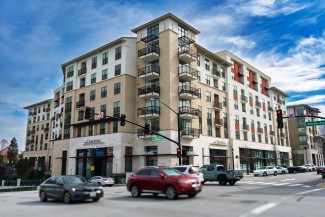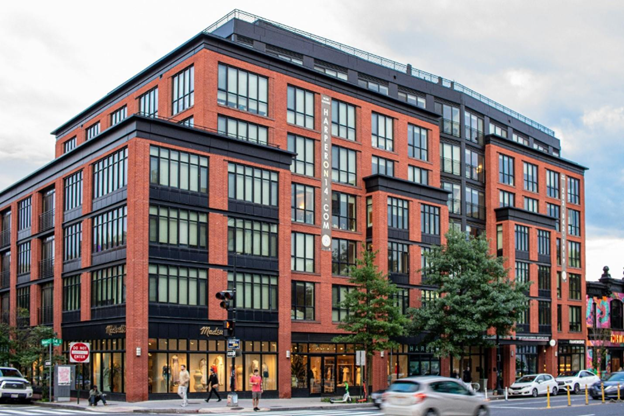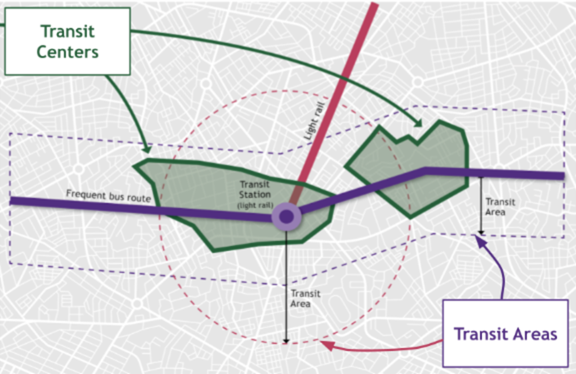Well-crafted transit-oriented development laws can expand affordable housing, improve mobility, and cut climate pollution. Several states have passed laws to remove local barriers to dense development that can serve as models for other states.
States are increasingly taking the lead in advancing transit-oriented development (TOD)—the intentional effort to build dense, walkable, and mixed-use districts near public transit. TOD is a key strategy for cutting transportation emissions. While local governments typically control zoning and permitting, state legislation can help remove barriers to compact, transit-accessible development.
The Benefits of TOD
Research in Los Angeles finds that dense development within half a mile of major rail stations can generate greenhouse gas (GHG) emissions savings of up to 40% and improve air quality by 30% over 60 years compared to development half a mile to two miles from stations. These gains stem from shorter travel distances, as well as trips shifting to transit, walking, or biking, which also helps to alleviate traffic. Households in TODs also save about $1,200 per year on transportation costs.
A mixed-use development in Washington, D.C. Apartments sit atop a clothing retailer, an optician, and a picture frame store. The building is a five-minute walk from WMATA’s U Street Rail Station. Photo credit: Zoshua Colah.
Some jurisdictions have restrictive zoning and parking requirements near transit that often limit density and raise costs. By easing these restrictions to allow more housing and mixed-use development near transit stops, TOD policies can make it less costly to build and spur the development of market-rate housing, helping address housing shortages. They can also boost affordable housing by incentivizing or requiring the inclusion of affordable units.
States can support TOD through well-designed legislation
Earlier this year, Maryland considered legislation to remove minimum parking requirements near transit, among other TOD-friendly policies, but legislators did not pass the bill. To help inform future state TOD laws, we’ve compiled best practices based on lessons learned from recent state laws. The best practices draw from the following state-led initiatives to reduce barriers to increased housing development near transit:
- A California law passed in October that allows greater residential density within half a mile of certain rail stations and bus rapid transit stops
- Legislation passed in Washington State in May that allows greater residential and mixed-use development density near transit stops
- A Colorado law enacted last year that allows greater residential density within locally designated “transit centers” near certain transit stops
- California legislation from 2022 that prohibits minimum parking requirements near certain transit stops
- Another 2022 California law that allows housing development in commercial areas near transit
- Ensure that compliance is straightforward for local governments, and include options for flexibility
States should make it relatively easy for local governments to comply with state TOD policy. Massachusetts saw the pitfalls of overly complicated guidelines with its 2021 MBTA Communities law, which required local governments to allow dense, multifamily housing near transit. The guidelines developed by the state’s Executive Office of Housing and Livable Communities were complex, requiring significant time and money for local governments to develop compliant zoning plans. Washington avoided this mistake under its TOD law. In Washington, if local governments are not in compliance by the deadline, a model ordinance developed by the state’s Department of Commerce takes effect.
Building flexibility into state-led TOD policy can make it easier for local governments to comply while tailoring development to local conditions. For example, Washington’s TOD policy requires certain jurisdictions to allow an average floor area ratio (FAR), or ratio of a building’s square footage relative to its lot size, of 3.5 near rail stations. Localities can vary FAR limits across areas near stations as long as the overall average is at least 3.5. This means that, on average, buildings with a square footage that is 3.5 times greater than the area of the lots they are built on must be allowed. Similarly, Colorado’s TOD law allows local governments to designate "transit centers" within predefined transit areas. The number of housing units allowed across all transit centers must be greater than or equal to a specific housing opportunity goal, which is determined based on the total acreage of the transit areas. This means that some transit centers can allow fewer units, and some can allow more, so long as the goal is met.
An example of two transit areas, designated by Colorado’s 2024 TOD law, and two transit centers, designated by the local government, within the transit areas. Source: Colorado Department of Local Affairs.
- Allow mixed-use development to enable shorter trips
TOD legislation should allow mixed-use development (including both residential and commercial buildings) near transit to maximize the services that residents and other transit riders can easily access. Colorado and Washington included both multifamily and mixed-use development as allowable uses near transit in their TOD laws.
- Incorporate affordability requirements or incentives to make new housing accessible to all
States can use requirements or incentives for affordability to ensure that a portion of new housing is accessible to low-income residents. For example, Washington’s law requires all residential developments built within transit station areas to include a certain percentage of affordable units. Colorado adopted a more flexible approach by requiring jurisdictions to implement a select number of affordability and displacement mitigation strategies from a menu of options.
Potential incentives include offering streamlined review processes in exchange for building a certain number of affordable units, as California did, or impact fee reductions and property tax exemptions for a period of time, like in Washington.
- Reduce development costs and timelines to encourage new development
One way to reduce development costs is by removing minimum parking requirements for projects near transit. These requirements often mandate more parking spaces than a developer would otherwise build, leaving less space for housing or commercial uses and driving up costs.
Additionally, states can minimize timelines by allowing development by-right, rather than requiring a discretionary approval process. The review process for by-right development is typically much more streamlined and predictable, incentivizing developers to build in these areas. Colorado’s law requires local governments to consider multifamily developments under five acres near transit by-right.
- Provide funding and technical assistance for local governments
States can create grant programs to support water, sewer, transportation, and other infrastructure needed to support new developments near transit, such as Colorado’s Transit-Oriented Communities Infrastructure Grant Program.
States can also offer technical assistance to local governments in addition to clear guidance and the geospatial and analytical tools needed. For example, local governments can contact Colorado’s Department of Local Affairs to obtain answers to specific questions, a review of draft code, and assistance with technical tools.
Meeting the need through intentional policymaking
States legislatures have the opportunity to join a growing number of states that have taken steps to increase affordable housing and services near frequent transit. TOD laws should increase allowable density, incentivize or require affordability, reduce the cost of development, and provide flexibility and support to local governments. When crafted carefully, statewide TOD policies can bring numerous benefits to local communities while acknowledging the different needs of each community.



